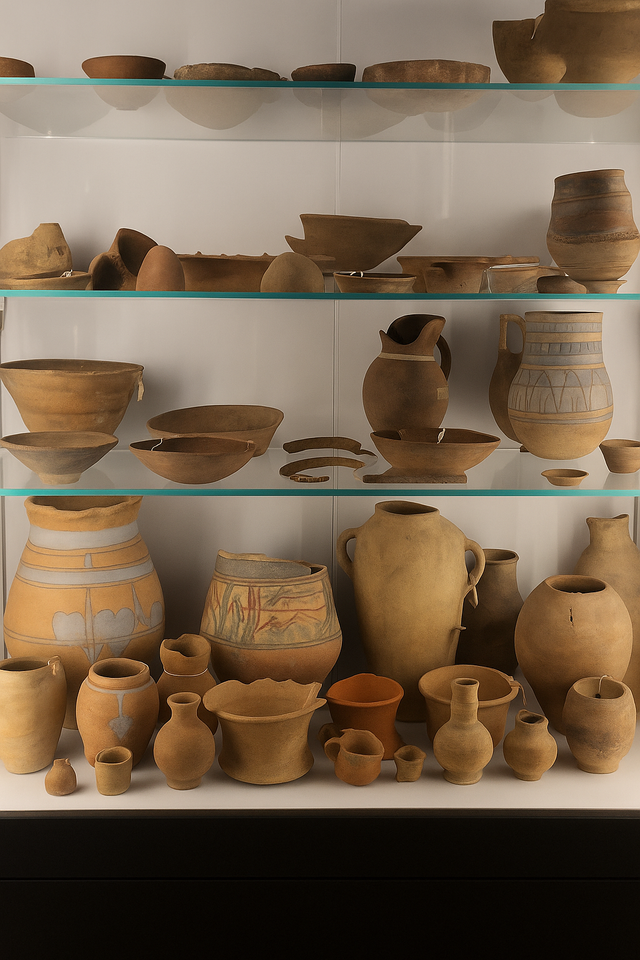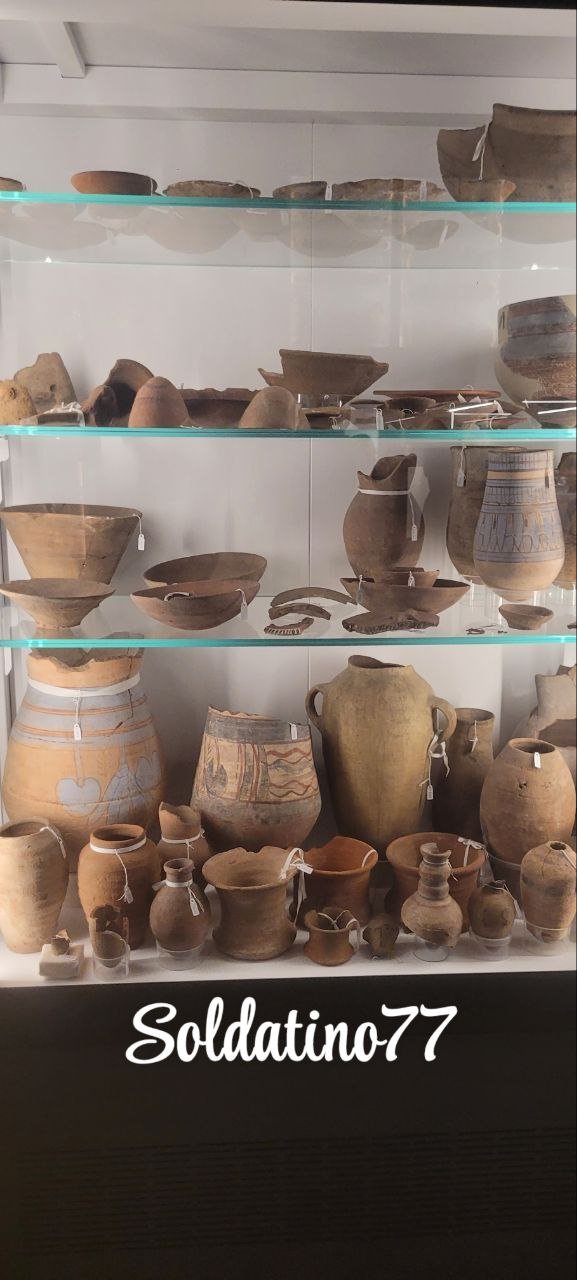Vasi in terracotta dell' Antico Egitto 🏺🔥
Si tratta di vetrine contenenti ceramiche e vasi egizi, risalenti a periodi diversi, ma in gran parte databili tra il Predinastico (circa 4000–3000 a.C.) e l’Antico Regno (2686–2181 a.C.).
Questi vasi in terracotta venivano utilizzati per:
- Conservare acqua, birra, vino e oli.
- Contenere granaglie e derrate alimentari.
- Raccogliere oli profumati e unguenti per uso personale e rituale.
- Servire come oggetti di corredo funerario, affinché il defunto avesse a disposizione beni essenziali nell’aldilà.
Si può anche notare che:
- Alcuni presentano decorazioni dipinte con motivi geometrici o simbolici (come onde, piante di papiro o linee orizzontali), tipiche delle ceramiche di Naqada II–III.
- Altri sono più semplici, in argilla rossastra o gialla, con forme che vanno dalle brocche panciute alle coppe basse.
- La varietà delle forme indica i diversi usi domestici e rituali.
- Le etichette e i legacci che vedi servono a catalogare e mantenere i frammenti ordinati, molti di questi vasi sono stati restaurati a partire da frammenti rinvenuti durante gli scavi.
Le ceramiche erano prodotte impastando argilla del Nilo con sabbia o paglia per aumentarne la resistenza. Dopo la foggiatura manuale o su tornio lento, venivano cotte in forni rudimentali e talvolta lucidate con pietre per ottenere superfici brillanti.
Queste vetrine dimostrano quanto fosse avanzata la tecnologia ceramica nell’antico Egitto e come la produzione di vasi fosse strettamente connessa alla vita quotidiana, ai riti religiosi e alle credenze sull’aldilà.
Quale aspetto vi affascina di più? Le diverse forme progettate per gli usi quotidiani o le decorazioni simboliche e rituali? Scrivetelo nei commenti e lasciate un like se amate immergervi nei dettagli della vita nell’antico Egitto! 🏺🌾✨
La prima foto l'ho creata con l'intelligenza artificiale mentre le altre le ho scattate personalmente al Museo degli Egizi 📸🕵🏻♂️🏛️
Traduzione in inglese 🇬🇧
These are display cases containing Egyptian ceramics and jars, dating from various periods but largely from the Predynastic Period (c. 4000–3000 BCE) to the Old Kingdom (2686–2181 BCE).
These terracotta vessels were used for:
- Storing water, beer, wine, and oils.
- Holding grains and food supplies.
- Collecting scented oils and ointments for personal and ritual use.
- Serving as funerary goods, ensuring the deceased had essential items available in the afterlife.
You can also note that:
- Some feature painted decorations with geometric or symbolic motifs (such as waves, papyrus plants, or horizontal lines), typical of Naqada II–III ceramics.
- Others are simpler, made of reddish or yellow clay, with shapes ranging from rounded jugs to shallow bowls.
- The variety of shapes indicates their diverse domestic and ritual uses.
- The tags and ties you see are used to catalogue and keep the fragments organized, as many of these vessels have been restored from pieces found during excavations.
The ceramics were made by mixing Nile clay with sand or straw to increase durability. After being shaped by hand or on a slow wheel, they were fired in rudimentary kilns and sometimes polished with stones to achieve a shiny surface.
These display cases demonstrate how advanced ceramic technology was in ancient Egypt and how the production of vessels was closely connected to daily life, religious rites, and beliefs about the afterlife.
Which aspect fascinates you the most? The different shapes designed for everyday use or the symbolic and ritual decorations? Share your thoughts in the comments and leave a like if you love diving into the details of life in ancient Egypt! 🏺🌾✨
The first photo was created using artificial intelligence, while the others were personally taken by me at the Egyptian Museum 📸🕵🏻♂️🏛️



Ottimo post, grazie soldatino77. I vasi raccontano arte, usi e costumi di un popolo. Sapere che alcuni di quelli che ci hai mostrato sono del 3000 a.C. fa impressione
veramente impressionante sapere che li han fatti cosi tanto tempo fa questi vasi , e sono conservati cosi bene e fatti di una fattura lodevole , veramente un popolo molto affascinante gli egizi